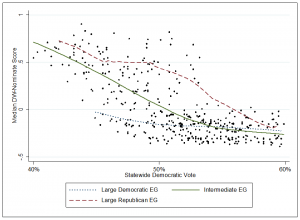I wrote yesterday about my findings in a recent paper about the causes of district plans’ partisan skews. In a nutshell: Full control of the redistricting process consistently benefits the party in charge. Courts, commissions, and divided governments don’t reliably favor either party. Greater black representation produces a small pro-Republican shift, which disappears if Democrats are responsible for redistricting. And greater urbanization also produces a small pro-Republican shift, but only at the state house level.
Today I want to talk about the consequences of district plans’ partisan tilts. In particular, how does a large efficiency gap (or partisan bias) affect the legislative representation that voters get? The below chart begins to answer this question. The x-axis shows the Democratic share of the statewide vote in congressional elections from 1972 to 2012. The y-axis shows the ideological midpoint of each state’s congressional delegation (where negative values are liberal and positive values are conservative). Separate curves are plotted for plans with large pro-Democratic efficiency gaps (>10%), large pro-Republican efficiency gaps (<-10%), and all other efficiency gaps.

It is obvious from the chart that, at least in competitive states, gerrymandering has an enormous impact on representation. Take a state where the congressional vote is evenly split between the parties. If this state has a large pro-Democratic efficiency gap, then its median House member is likely to have an ideal point around -0.2 (or somewhat liberal). If the state has an intermediate efficiency gap, then the ideological midpoint of its House delegation is likely to be near zero (or moderate). And if the state has a large pro-Republican efficiency gap, then its median House member is likely to have an ideal point close to 0.4 (or quite conservative). Thus without a single voter changing her mind, redistricting can shift the ideological midpoint of a House delegation by about 0.6, or roughly two standard deviations. The same electorate can be represented in Congress in completely different ways, depending on how the lines are drawn.
I won’t get into my regression analysis here, but it strongly confirms the story told by the chart. Both the efficiency gap and partisan bias are powerful drivers of congressional representation in every model. What this means, in my view, is that the damage of gerrymandering is not limited to discrepancies between votes cast and seats won. It extends, rather, to the voting records of the legislators who end up in office. Pro-Democratic gerrymanders result in House members who are too liberal for their constituents. Pro-Republican gerrymanders yield House members who are overly conservative. Either way, the basic idea that legislators should be aligned with the voters who elected them is severely compromised.